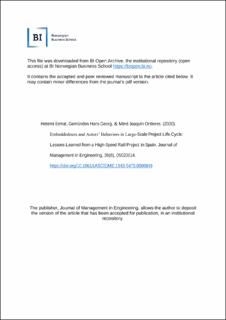Embeddedness and actors’ behaviors in large-scale project lifecycle: Lessons learned from a High-Speed Rail project in Spain
Journal article, Peer reviewed
Accepted version
Permanent lenke
https://hdl.handle.net/11250/2786029Utgivelsesdato
2020Metadata
Vis full innførselSamlinger
- Scientific articles [2181]
Originalversjon
Journal of Management in Engineering, 36(6), 05020014. 10.1061/(ASCE)ME.1943-5479.0000849Sammendrag
Despite wide-ranging research on large-scale infrastructure project performance, little is known about the role that project public institutional context and project owner’s response capability plays in the governing process. Building on a theoretically driven approach and a case study, we first established a set of propositions, and then substantiated this set through empirical illustrations. This study investigated the multi-actor Madrid–Barcelona high-speed rail line (HSL) project (1990–2017) with the use of social network analysis supplemented by qualitative evidence. The findings show that actors’ behavior is affected by the project public institutional context, coupled with contractual commitments. A closer examination of the data found two factors that drive the escalation dynamics: (1) the timing mismatches—a ubiquitous feature of public sector project owners’ organization—leading to the incapacity to influence governance during the project front-end and (2) owners’ passive behavior during implementation. From the management perspective, an active owner with high project response capability is necessary for effectively interacting with contractors, and for selecting and managing both contractual and trust-based governance mechanisms effectively. Based on the findings, the authors offer theoretical and managerial implications for promoting the effectiveness of owner-contractor collaboration in large-scale infrastructure projects.
